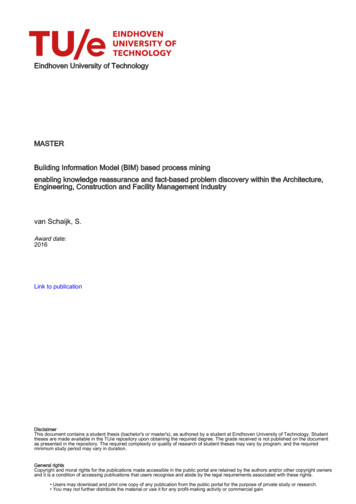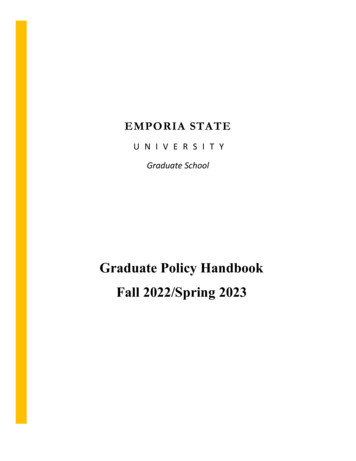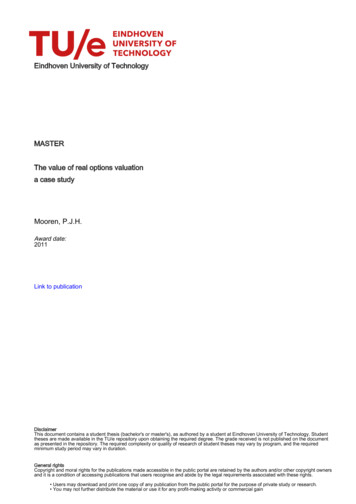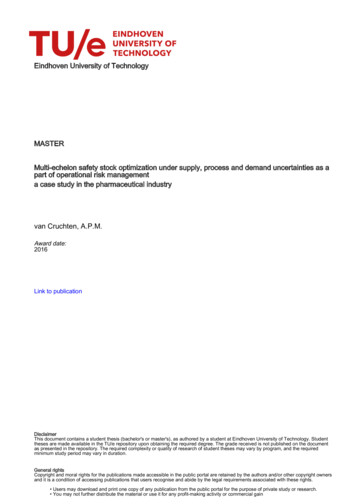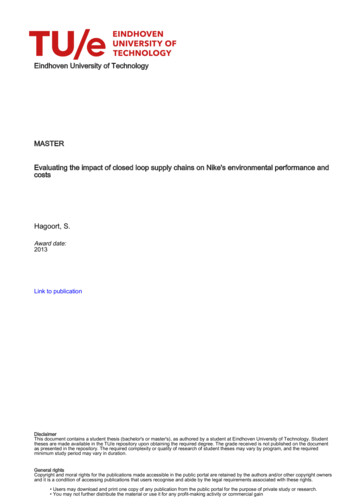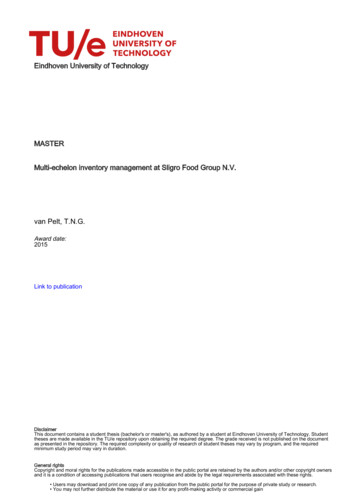
Transcription
Eindhoven University of TechnologyMASTERMulti-echelon inventory management at Sligro Food Group N.V.van Pelt, T.N.G.Award date:2015Link to publicationDisclaimerThis document contains a student thesis (bachelor's or master's), as authored by a student at Eindhoven University of Technology. Studenttheses are made available in the TU/e repository upon obtaining the required degree. The grade received is not published on the documentas presented in the repository. The required complexity or quality of research of student theses may vary by program, and the requiredminimum study period may vary in duration.General rightsCopyright and moral rights for the publications made accessible in the public portal are retained by the authors and/or other copyright ownersand it is a condition of accessing publications that users recognise and abide by the legal requirements associated with these rights. Users may download and print one copy of any publication from the public portal for the purpose of private study or research. You may not further distribute the material or use it for any profit-making activity or commercial gain
Eindhoven, December 14Multi-echelon inventorymanagementat Sligro Food Group N.V.byvan Pelt, T.N.G.BSc Industrial Engineering and Management Science – TU/e 2012Student identity number 0717966In partial fulfilment of the requirements for the degree ofMaster of Sciencein Operations Management and LogisticsSupervisors:dr. ir. R.A.C.M. Broekmeulen, TU/eprof. dr. A.G. de Kok, TU/edrs. N. Kuipers, Sligro Food Group N.V.
TUE. School of Industrial EngineeringSeries Master Theses Operations Management and LogisticsSubject headings: inventory control, supply chain managementii
AbstractSligro Food Group N.V. considers the application of an integrated inventory control policy in whichcrucial information is shared among the different stock points in its supply chain. The actual decisionfor the implementation depends on the (monetary) benefit of the application of a new inventorycontrol policy. In support of this decision, this report describes the research which results into thepotential inventory holding cost savings of the application of an installation stock policy with centraldemand pooling – in which downstream demand data is shared with the CDC – and of theapplication of a (near-)optimal multi-echelon inventory control policy – in which the inventory of allstock points is centrally managed – with respect to the current application of a regular installationstock policy. Moreover, a potential cost saving classification is constructed based on thecharacteristics which seem to affect the cost saving potentials. Although the results are quiteimpressive, the recommendation comprises the execution of a pilot-project by Sligro Food GroupN.V. which should validate these findings and which should also provide insight on the impact theapplication of another inventory control policy has on other logistical cost aspects.iii
PrefaceThe current report is the result of my master thesis project performed at Sligro Food Group N.V.which constitutes the final stage of the master Operations Management and Logistics at EindhovenUniversity of Technology. With the completion of this master thesis project, my pleasant andinstructive studentship at Eindhoven University of Technology has come to an end.I performed my master thesis project from March to November 2014. Most of that time, I worked atthe Sligro inventory management department at the headquarter in Veghel. I really enjoyed thegreat cooperation and support from all the inventory planners and other staff, as well as all projectand non-project related discussions we had. I have not only learned much from performing mymaster thesis project in itself, but also from operating in a real, dynamic business environment. Inparticular, I want to thank the head of the Sligro inventory management department, Nico Kuipers,for the time and effort he spent on the supervision of this project by providing critical but valuableand constructive feedback and by extensively contributing to our discussions regarding inventoryand supply chain management issues in the Sligro organization.Furthermore, I would like to thank my first TU/e supervisor Rob Broekmeulen for his useful guidanceduring the project, as well as critical but supportive attitude with respect to the decisions I took inthe course of the project. In addition, I would like to thank my second TU/e supervisor Ton de Kokfor his help and valuable feedback where needed.And last, but not least, thanks go out to my parents for providing me the opportunity to fulfil mymaster and for their unconditional and motivational support.Hopefully, the current report meets the expectations of the Sligro inventory managers andconstitutes a valuable supplement to the integrated inventory management business case.Tim van PeltEindhoven, December 14iv
Management SummaryA Dutch version of the management summary is included in Appendix A.Problem descriptionCurrently, the ABS and Slim4 inventory management systems generate replenishment decisions foreach stock point in the Sligro supply chain in isolation, merely based on their own individualinventory levels, sales forecasts and own delivery and replenishment preferences. With an eye onsupply chain efficiency and the shortcomings of the decentralized inventory control in the Sligrosupply chain, it is considered to be worthwhile to investigate whether focussing more intensively oninformation sharing within the Sligro supply chain results into lower cumulated inventory levels inthe supply chain and thus into an inventory holding cost reduction. Therefore, this research projectis initiated to determine what (theoretically) the cost saving potential is of the application of aninstallation stock policy with central demand pooling compared to the current application of aregular installation stock policy, and to determine how many cost savings can still be obtained byapplying a (near-)optimal multi-echelon inventory policy in the Sligro supply chain. An installationstock policy with central demand pooling implies that although replenishment decisions are justtaken for each stock point individually, at the central warehouse down-stream point-of-salesdemand data instead of the actual incoming demand is used to set the required inventory levels.Besides, it is investigated how the cost saving potentials of the demand pooling installation stockand multi-echelon policies differ among the different articles. In other words, the impact isdetermined of the article characteristics related to demand and supply on the cost saving potential.Problem scopeOnly stock points are incorporated into this research project where no “commercial play” takesplace; the in-scope stock points are the CDC, RDCs and the BSs. Moreover, only articles areconsidered for which inventory is held as well at the CDC as at the RDCs and/or BSs sinceinformation sharing only plays a role in a multi-echelon system. Besides, from the logistical trinitytransportation-storage-handling, only the storage component (inventory holding costs) is consideredwithout taking into account its impact on the other two components.Problem analysisIn total, 11.449 different stock-keeping-units (SKUs) are in-scope of this project, of which 1.310 SKUsare in the assortment of the RDCs and 10.472 SKUs in the assortment of the BSs. For the RDCs, this isin number of SKUs and in value merely roughly 10% of the entire assortment; while for the BSs itconstitutes almost 35% of the entire assortment and represents 70% of the total sales value. It turnsout that over 2013 for these in-scope SKUs a fill rate of 98,7% was realized for the BS customers andthat the service level offered at the RDCs equalled just 92,2%. Internally, the service levels from theCDC to the BSs and RDCs equalled around 96%. These internal service levels from the CDC as well asfrom the RDCs to the EMTÉs are particularly high and it is expected that these can significantly belowered while still be able to deliver the same service at the EMTÉ-stores. In order to realize this, onaverage, in total more than 45 million euros are invested in inventories of the in-scope SKUs. Thiscorresponds to an average of eight weeks of inventory held in the Sligro supply chain. Looking at thedistribution of the in-scope inventory among the Sligro chain, it turns out that 48% of the inventoryis located downstream and the other 52% upstream at the CDC. Therefore, it can be concluded thatv
relatively much inventory is held at the CDC, while this does not directly contribute to the serviceoffered to the customers.The current supply chain performance of Sligro does not merely result from the intended functioningof ABS and Slim4. It turns out that, on average, the inventory managers at the RDCs and BSs adaptaround 16% of their ABS order advices, while at the CDC even around 36% of the order advicesgenerated by Slim4 are manually adapted. These order advice adaptations conceal the performancewhich would have been achieved when ABS and Slim4 functioned autonomously because orderadvice adaptations can affect the service and inventory costs positively but also negatively.Research designThree scenarios are defined according to the research problem. The benchmark scenario comprisesthe application of a (R,S)-policy at the BSs/RDCs and a (R,s,nQ)-policiy at the CDC. The demandpooling scenario imitates a similar situation as in the benchmark scenario despite that the logic ofaggregate demand forecasting at the CDC is applied. These two installation stock policy scenarios areevaluated with the use of the DoBr tool. The third scenario imitates a situation in which a real multiechelon inventory management policy is applied in the Sligro supply chain. This optimal scenario isevaluated with the ChainScope tool. The relative reductions in inventory investments and inventoryholding costs for the latter two scenarios are determined by expressing the inventory values perscenario-internal fill rate-target fill rate combination as index numbers with the inventory value ofthe regular installation stock policy with unchanged fill rates as base value. The absolute cost savingpotentials are determined by simply subtracting the total inventory costs of the second or thirdscenario from the total inventory costs of the first scenario. The considered output measures arebesides to the monetary values of the inventory investments and inventory holding costs also thenumber of inventory turnover weeks, since this implicitly also affects the quality offered by Sligro.The objective of the evaluation of each scenario is to minimize the sum of the total inventory holdingcosts over all in-scope stock points and SKUs. Thus, the (average) inventory levels implicitly are thedecision variables in the optimization problem. The RDC and BS supply chain parts are evaluatedseparately so that a costs saving potential per supply chain part is obtained and a possibleimplementation of an integrated inventory management system can be considered for both theretail chain and BS-chain individually. The evaluations are based on a sample of 1200 BSs SKUs and300 RDCs SKUs for which demand and supply data was available for entire 2013. The input variablesconsidered in the optimization of the (average) inventory levels constitute the constraints to theoptimization problem. Logically, at first target customer fill rates are defined per SKU, as well asinternal target fill rates for the evaluation of the installation stock policies. Besides, review periodsare included in the evaluation, as well as the expected lead times and the variations of the leadtimes. Furthermore, minimal order quantities and base replenishment quantities are incorporated inthe analysis. Lastly, demand per SKU is characterized by the average daily demand and the forecastcorrected daily demand variance. The factors considered in the cost saving potential classificationsare the CDC review period, the weighted average BS/RDC review period, the average CDC lead time,the coefficient of variation of the CDC lead time, the relative base replenishment quantity, and theaverage total daily demand. Per factor HIGH and LOW classes are defined and it is tested whethersignificant differences could be found in the cost saving potentials between different combinationsof factor classes.vi
ResultsAs expected, aggregate demand forecasting based on shared down-stream demand data indeedresults into a lower demand uncertainty at the CDC for nearly all SKUs. The average volatility of theaggregate demand at the CDC amounts even only roughly half of the average volatility of the actualincoming CDC demand. Assuming unchanged internal and external fill rates, this reduction in CDCdemand variability results into a 27% decrease in inventory investment and inventory holding costsin the BS supply chain part, and even up to a 58% decrease in the RDC supply chain part, withrespect to the benchmark scenario. Although the relative cost saving potential in the RDC supplychain part is double the relative cost saving potential in the BS supply chain part, due to the limitednumber of in-scope SKUs the absolute potential cost saving of 210.000 in the RDC supply chainpart is relatively small compared to the 730.000 potential holding cost reduction in the BS supplychain part. The relative and absolute cost saving potentials of the application of an installation stockpolicy with central demand pooling in the Sligro supply chain can even be amplified if moreover alower internal fill rate is pursued by the CDC. Illustratively, an additional approximatively 170.000holding cost reduction can be realized when the internal fill rate between the CDC and the BSs andRDCs is lowered to 0,8 in the demand pooling scenario, which equals a relative cost saving potentialof 36% compared to the benchmark scenario.Moreover, even more cost savings can potentially be realized in the different Sligro supply chainparts when the (near-)optimal situation is pursued. Assuming an unchanged external target fill ratein the demand pooling scenario, potential relative cost savings of 25% and 20% still remain withrespect to the demand pooling scenario for the BS and RDC supply chain parts respectively. Thesepotential cost saving percentages absolutely equal potential holding cost reductions of 610.000and 40.000 for the BS and RDC supply chain parts respectively. Thus, with respect to thebenchmark scenario, the Sligro inventory holding costs can roughly be halved from three millioneuros per year to one and a half million euros in the optimal scenario. In line with the expectations,these additional diminutions in the supply chain wide inventory levels can be realized by positioningthe major proportion of the total inventory of a SKU downstream in the Sligro supply chain at theBSs and/or RDCs.Besides, it can be concluded that most can be saved – both absolute and relatively – on SKUs with arelatively high (aggregate) demand and a relatively low base replenishment quantity Q at the CDC.RecommendationAlthough the above mentioned potential holding cost reductions are substantial, to make thetransition to another inventory control policy in the Sligro supply chain worthwhile, the holding costsavings should outweigh the initial expenditures and additional handling and transportation costs ofthe application of another inventory control policy. Therefore, the recommendation to the heads ofthe Sligro inventory management department is twofold: firstly, examine the suitability of theexisting and other inventory management systems to accurately apply the installation stock policywith central demand pooling or the optimal multi-echelon inventory control policy in the Sligrosupply chain; secondly, set up a pilot project regarding the application of another inventory controlpolicy to validate the theoretical holding cost saving potentials and to determine the impact of it onother inventory control related activities and costs. Besides to the adoption of another inventorycontrol policy, it is also advised to change the inventory planner’s daily operations and the way inwhich their performance is assessed in line with the new inventory control policies.vii
Table of contentsAbstract . iiiPreface . ivManagement Summary . v1.2.3.4.5.Introduction . 11.1Problem introduction . 11.2Problem context. 11.3Project approach . 3Problem statement . 52.1Problem description . 52.2Problem scope . 62.3Research questions . 8Literature overview . 103.1Inventory management aspects . 103.2Inventory management at retail distribution systems . 113.3Implementation . 153.4Research contribution. 16Problem analysis . 174.1Inventory management systems. 174.2Order advice adaptation . 174.3Current performance . 19Research design . 225.1Modelling . 225.2Scenarios . 335.3Tools . 355.4Data . 375.5Model validation . 38viii
5.66.Methodology. 38Results & discussion . 436.1BSs supply chain part . 436.2RDCs supply chain part . 476.3Total Sligro supply chain . 506.4Cost savings classification . 517.Conclusion & recommendation . 558.Limitations and future research. 608.1Research limitations. 608.2Suggestions for future research . 62References . 63List of abbreviations & symbols . 68List of figures . 71List of tables . 74Appendix A: Dutch management summary . 76Appendix B: Key Figures Sligro Food Group N.V. . 80Appendix C: Current inventory management systems . 81Appendix D: Data preparation / analysis / processing steps . 84Appendix E: Graphical representation performance analysis . 95Appendix F: Order advice adaptation . 97Appendix G: DoBr tool . 100Appendix H: ChainScope . 103Appendix I: Correlation mean and st. deviation demand . 107Appendix J: Graphical representation determination E[OHS] . 108Appendix K: Scenario evaluation results. 109Appendix L: Cost saving potential classification . 118Appendix M: Scenarios, tools & evaluation differences . 122ix
1. IntroductionThis chapter firstly briefly introduces the problem addressed in this report and thereafter outlinesthe context of the problem. Afterwards, the project approach is explained, according to which theproject is executed and the remainder of the report is structured.1.1 Problem introductionInventory constitutes a significant fraction of the assets of a retail firm. According to Standard &Poor’s industry survey on general retailing, for example, ‘‘Merchandise inventories are a retailer’smost important asset, even though buildings, property and equipment usually exceed inventoryvalue in dollar terms’’ (Sack, 2000). Thus, the importance of improving inventory management inretail trade cannot be overemphasized (Gaur & Kesavan, 2009). Inventory is not only large in dollarvalue but also critical to the performance of retailers. Ensuring product availability when consumersneed it without holding too much inventory is critical to business performance since out-of-stocks(OOSs) can result in lost sales. Companies which are able to manage this balance successfully have astrong competitive advantage. It is therefore that more and more (retail) companies, including SligroFood Group N.V., focus nowadays on supply chain efficiency – offering a certain desired service levelat least costs. As part of this focus, Sligro Food Group N.V. strives for an inventory allocation over itssupply chain which balances the offered customer service level and related inventory costs.Recently, as part of the integrated inventory management business case, Sligro started a pilotproject regarding the implementation of the Slimstock inventory management software packageSlim4 in order to verify whether the use of such a (more) sophisticated inventory management toolresults into a more appropriate inventory allocation. Besides, Sligro Food Group N.V. initiated thecurrent research project to determine what (theoretically) the cost saving potential is of applying aninstallation stock policy with central demand pooling compared to a regular installation stock policy,and to determine how many cost savings can still be obtained by applying a (near-)optimal multiechelon inventory policy in the Sligro supply chain. Scientifically, this project can be considered as acase study on multi-echelon inventory management in a food retail/food service environment withrespect to the potential cost savings of different inventory management policies.In the remainder of the report is referred to Sligro Food Group N.V. as Sligro Food Group or simplySligro. Besides, inventory management policy, inventory control policy, replenishment policy andstock policy are used as synonyms. Moreover, important to keep in mind, integrated and centralinventory management refer to the central inventory control of all stock points in the Sligro supplychain instead of stocking inventory at one central location.1.2 Problem contextThe problem context should be taken into account when analysing a problem and designing andimplementing a possible solution. Therefore, before the actual problem is introduced, a companydescription of Sligro Food Group N.V. is provided and the Sligro supply chain is briefly described.1.2.1 Sligro Food Group N.V.Sligro Food Group N.V., established in 1935 in Veghel, encompasses food retail and foodservicecompanies selling directly and indirectly to the entire Dutch food and beverages market. The food1
retail activities comprise around 130 full-service EMTÉ supermarkets, of which around thirty areoperated by independent retailers. Sligro Food Group leads the Dutch foodservice market with anationwide network of cash-and-carry and delivery services serving large and small-scale bars andrestaurants, leisure facilities, volume users, company and other caterers, fuel retailers, small andmedium-sized enterprises, smaller retail businesses and the institutional market. The cash-and-carryactivities are served by 46 Sligro cash-and-carry wholesalers, while delivery services are provided bynine Sligro delivery centres and Van Hoeckel, which is fully focused on the institutional market. Thedelivery service customers can place orders via a completely customized order system called Slimis.Besides, Sligro Food Group also operates its own in-house production facilities for specializedconvenience products, fish and patisserie and delicatessen items, as well as a meat-processingcentre focusing on the retail market.The success of the Sligro Food Group activities depends primarily, both directly and indirectly, onconsumers’ spending behaviour in the Netherlands. However, consumers have been reducing theirexpenditure on food in 2013, as household budgets are squeezed by the continuing decline in realdisposable incomes in the Netherlands. The long-term trend in the market is that food service isgaining market share over food retail. Nevertheless, EMTÉ again outperformed the market in 2013,with like-for-like growth of 1.9%. EMTÉ is one of the few full-service supermarkets which managedto grow faster than the market, because a large proportion of the market growth was due to thehard discounters. Though, the medium-term focus for EMTÉ is mainly to improve existing operationswhich do not require heavy investment. The cash-and-carry Sligro stores also again outperformedthe market by a clear margin. The priority for food service is the market position in the mediumterm, focusing on structural growth in profitability while maintaining the right balance with shortterm results. The recently announced acquisitions of Rooswinkel and Horeca Totaal Sluis are thenext steps in that strategy and there may well be further moves towards consolidation. Sligro shalltherefore continue to invest actively in our market position and in our outlets, logistics and ICTinfrastructure. Besides, operating expenses are reduced through ongoing tight cost control and ajoint integral logistics strategy, of which the current project under consideration is a prime example.In order to be assured of sufficient purchasing power in the market, the food retail purchases arehandled by the Superunie co-operative purchasing organization, which has a 30% share of the Dutchsupermarket sector. As one of the largest players in the foodservice market, Sligro Food Grouphandles its own purchasing for these activities – worldwide and, where po
application of a (near-)optimal multi-echelon inventory control policy - in which the inventory of all stock points is centrally managed - with respect to the current application of a regular installation stock policy. Moreover, a potential cost saving classification is constructed based on the . decision variables in the optimization .
